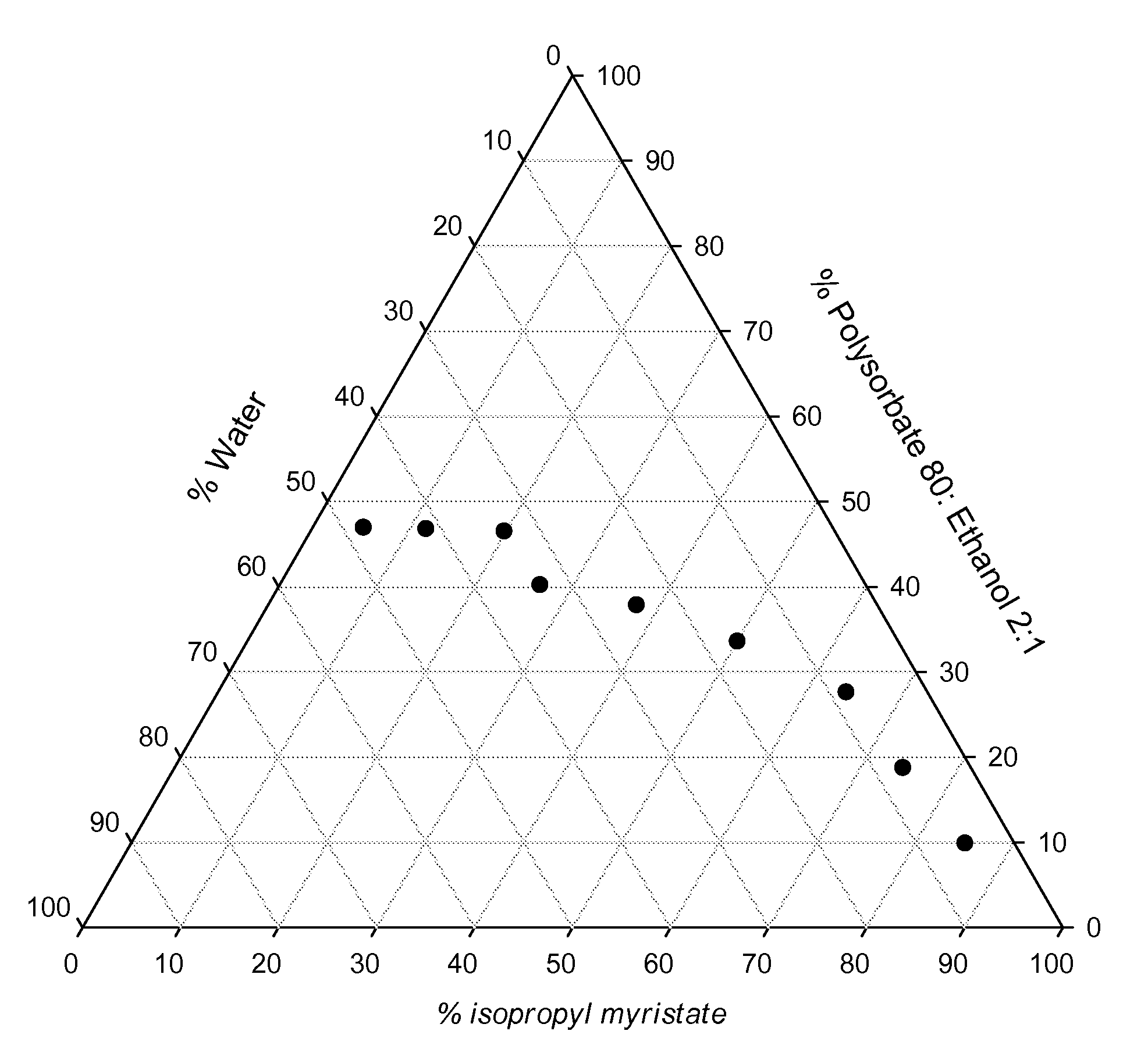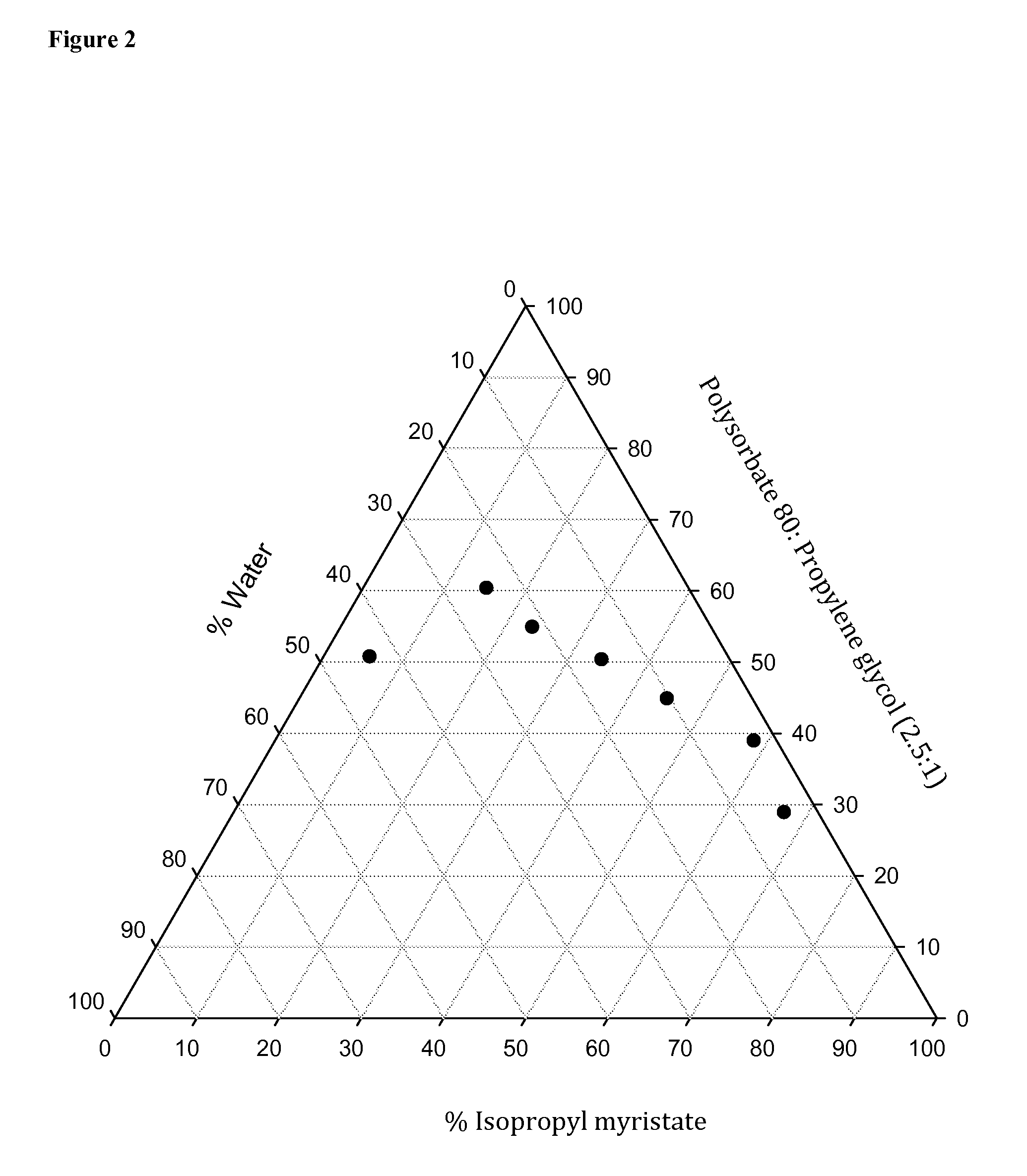Foamable Microemulsion Compositions for Topical Administration
a technology of foaming microemulsion and composition, which is applied in the direction of biocide, amide active ingredients, and aerosol delivery, etc., can solve the problems of ethanol and compositions containing ethanol being extremely flammable, ethanol-containing microemulsions for topical application have seen limited commercial use, and the effect of drying skin
- Summary
- Abstract
- Description
- Claims
- Application Information
AI Technical Summary
Benefits of technology
Problems solved by technology
Method used
Image
Examples
example 1
Lidocaine-Containing Foamable Microemulsion Composition with Ethyl Alcohol
[0319]An oil-in-water microemulsion was formed spontaneously when aqueous / co-surfactant, oil, and surfactant phases were mixed together in appropriate concentrations. The formed microemulsion was clear, optically isotropic and thermodynamically stable. The microemulsion was placed in an aerosol container and charged with 1,1,1,2-tetrafluoroethane (HFA 134a) propellant resulting in thermodynamically-stable, clear composition that dispensed as foam upon actuation.
[0320]The following manufacturing procedure was followed for preparation of various microemulsion concentrates and foamable microemulsion compositions: required quantities of DI water and ethyl alcohol (or glycol when ethanol-free compositions were made) were mixed in a container. Isopropyl Myristate was slowly added to the aqueous phase forming two-phase system. Then, polysorbate 80 was slowly added to two-phase system while mixing with prop mixer. Mix...
example 2
Lidocaine-Containing Foamable Microemulsion Composition without Ethyl Alcohol
[0323]Due to potential flammability hazard issues with ethyl alcohol at large scales and undesirable ethanol skin-drying properties, oil-in-water microemulsion was formulated without ethyl alcohol. Propylene glycol, glycerin and ethylene glycol were examined as ethyl alcohol replacements. Despite the fact that Hsiu-O et al. suggest that short chain alcohols (i.e., ethyl alcohol) are required as co-surfactants for producing microemulsions, we were able to formulate stable microemulsion concentrates and foamable microemulsion compositions without ethyl alcohol. Microemulsion concentrate #2 was charged with HFA 134a, and a single-phase system was formed that upon actuation produced foam. HFA 134a level was 6% (w / w).
Microemulsion Concentrate #2
[0324]
Ingredient%, w / wPropylene Glycol15.00DI Water21.50Lidocaine4.00Polysorbate 8041.10Isopropyl Myristate16.30Benzalkonium Chloride0.02Benzyl Alcohol2.06Total100.00
example 3
Microemulsions with Water, Isopropyl Myristate, and Polysorbate 80 / Ethanol Mixture
[0325]Using ethanol as a co-surfactant, a ternary phase diagram was identified showing the combinations of water, oil and surfactant / co-surfactant under which a clear microemulsion system can be formulated. FIG. 1 shows the phase diagram of microemulsion systems indicating the emulsion / microemulsion phase boundary at various concentrations of water, isopropyl myristate (IPM), and polysorbate 80:ethanol (2:1). Polysorbate 80 is also referred to as “Tween® 80” or “Tween 80” and vice versa. The concentrations of each constituent of the microemulsions are depicted in the following table.
% Polysorbate 80:Ethanol(2:1) (w / w)% IPM (w / w)% DI water (w / w)9.7885.215.0118.6574.426.9327.5264.228.2633.4750.1316.4037.7537.7124.5440.1026.7133.1946.4219.8933.6946.6811.7741.5546.855.3047.84
PUM
| Property | Measurement | Unit |
|---|---|---|
| composition | aaaaa | aaaaa |
| weight | aaaaa | aaaaa |
| chain-length | aaaaa | aaaaa |
Abstract
Description
Claims
Application Information
 Login to View More
Login to View More - R&D
- Intellectual Property
- Life Sciences
- Materials
- Tech Scout
- Unparalleled Data Quality
- Higher Quality Content
- 60% Fewer Hallucinations
Browse by: Latest US Patents, China's latest patents, Technical Efficacy Thesaurus, Application Domain, Technology Topic, Popular Technical Reports.
© 2025 PatSnap. All rights reserved.Legal|Privacy policy|Modern Slavery Act Transparency Statement|Sitemap|About US| Contact US: help@patsnap.com



